 W
WThe American Revolutionary War (1775–1783), also known as the American War of Independence, was initiated by the thirteen American colonies in congress against Great Britain over their objection to Parliament's taxation policies and lack of colonial representation. From their founding in the 1600s, the colonies were largely left to govern themselves. With the capture of French Canada in the French and Indian War and confirmation of British victory in 1763, the British government was left deeply in debt, and the colonial legislatures vigorously disputed being forced to pay the expenses of the war. The Stamp Act and Townshend Acts provoked colonial opposition and unrest, leading to the 1770 Boston Massacre and 1773 Boston Tea Party. When Parliament answered with punitive measures imposed upon Massachusetts, twelve colonies responded with the First Continental Congress to boycott British goods.
 W
WThe affair of Fielding and Bylandt was a brief naval engagement off the Isle of Wight on 31 December 1779 between a Royal Navy squadron, commanded by Commodore Charles Fielding, and a naval squadron of the Dutch Republic, commanded by rear-admiral Lodewijk van Bylandt, escorting a Dutch convoy. The Dutch and British were not yet at war, but the British wished to inspect the Dutch merchantmen for what they considered contraband destined for France, then engaged in the American War of Independence. Bylandt attempted to avoid the engagement by offering the ships' manifests, but when Fielding insisted on a physical inspection, Bylandt put up a brief show of force, before striking his colours. The British then seized the Dutch merchantmen and conducted them as prizes to Portsmouth, followed by the Dutch squadron. The incident worsened the diplomatic relations between Great Britain and the Dutch Republic almost to breaking point. It also contributed to the formation of the First League of Armed Neutrality to which the Dutch acceded in December, 1780. To prevent their receiving assistance from other members of that League, Britain declared the Fourth Anglo-Dutch War shortly afterwards.
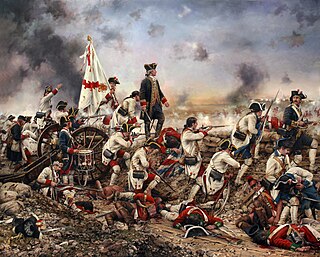 W
WSpain played an important role in the independence of the United States, as part of its conflict with Britain. Spain declared war on Britain as an ally of France, itself an ally of the American colonies. Most notably, Spanish forces attacked British positions in the south and captured West Florida from Britain in the Siege of Pensacola. This secured the southern route for supplies and closed off the possibility of any British offensive through the western frontier of United States via the Mississippi River. Spain also provided money, supplies and munitions to the American forces.
 W
WThe British Army during the American Revolutionary War served for eight years in campaigns fought around the globe. Defeat at the Siege of Yorktown to a combined Franco-US force ultimately led to the loss of the Thirteen Colonies in eastern North America, and the concluding Treaty of Paris deprived Britain of many of the gains achieved in the Seven Years' War. However several victories elsewhere meant that much of the British Empire remained intact.
 W
WMound Cemetery in Marietta, Ohio is a historic cemetery developed around the base of a prehistoric Adena burial mound known as the Great Mound or Conus. The city founders preserved the Great Mound from destruction by establishing the city cemetery around it in 1801.
 W
WThe Cherokee–American wars, also known as the Chickamauga Wars, were a series of raids, campaigns, ambushes, minor skirmishes, and several full-scale frontier battles in the Old Southwest from 1776 to 1795 between the Cherokee and American settlers on the frontier. Most of the events took place in the Upper South. While the fighting stretched across the entire period, there were extended periods with of little or no action.
 W
WConstitution Island is located on the east side of the Hudson River directly opposite the U.S. Military Academy Reservation and is connected to the east shore by Constitution Marsh.
 W
WContinental Army Encampment Site is a historic site located at Wilmington, New Castle County, Delaware. The Continental Army troops camped on the east side of Brandywine Creek, which is now a part of Brandywine Park. An early mill race is still visible, on the site, a reminder of the extensive early milling industry on the Brandywine. The Continental Army camped at the site for a few days before the Battle of Brandywine in August 1777. On December 21, 1777, 1,500 Delaware and Maryland troops under the command of General William Smallwood returned to the campsite. These troops were stationed to prevent occupation of Wilmington by the British and to protect the flour mills on the Brandywine.
 W
WThe first League of Armed Neutrality was an alliance of European naval powers between 1780 and 1783 which was intended to protect neutral shipping against the Royal Navy's wartime policy of unlimited search of neutral shipping for French contraband. British naval commanders followed their instructions with care, ordered away boarding parties and made seizures with impunity. Four fifths of ships sailing, according to one estimate, made port in safety, but it was the loss of the other fifth that rankled. By September 1778, at least 59 ships were taken prize-8 Danish, 16 Swedish and 35 Dutch, not mentioning others from Prussia. Protests were enormous by every side involved.
 W
WThe Capture of Fort William and Mary took place in New Hampshire on December 14, 1774, when local Patriots from the Portsmouth area, led by John Langdon, stormed Fort William and Mary and seized the garrison's powder, which was distributed through several towns in the colony for potential use in the looming struggle against Great Britain. On December 15, 1774, patriots led by John Sullivan again raided the fort, this time seizing numerous cannons.
 W
WFrench involvement in the American Revolutionary War of 1775–1783 began in 1775, when France, a hotbed of various radical Enlightenment ideas and long-term historical rival of the Kingdom of Great Britain, secretly shipped supplies to the Continental Army when it was established in June 1775. A Treaty of Alliance followed in 1778, which led to French shipments of money and matériel to the United States of America. Subsequently, Spain and the Dutch Republic also began to send assistance, which along with political developments in Europe left the British with no allies during the conflict. Spain openly declared war, with the Dutch following soon after.
 W
WThe Franco-American alliance was the 1778 alliance between the Kingdom of France and the United States during the American Revolutionary War. Formalized in the 1778 Treaty of Alliance, it was a military pact in which the French provided many supplies for the Americans. The Netherlands and Spain later joined as allies of France; Britain had no European allies. The French alliance was possible once the Americans captured a British invasion army at Saratoga in October 1777, demonstrating the viability of the American cause. The alliance became controversial after 1793 when Britain and Revolutionary France again went to war and the U.S. declared itself neutral. Relations between France and the United States worsened as the latter became closer to Britain in the Jay Treaty of 1795, leading to an undeclared Quasi War. The alliance was defunct by 1794 and formally ended in 1800.
 W
WGeneral Glover Farm is a historic 1700s farmhouse on a 2.4 acre property on the Marblehead - Swampscott - Salem border. Originally owned by a British Loyalist William Browne prior to the American Revolution, it was confiscated by the colonial Massachusetts government.
 W
WThe George Rex Flag was a protest flag used in the Province of New York at the start of the American Revolutionary War. The flag was adopted following the passage of the Quebec Act 1774 whereby French Roman Catholics were granted emancipation and Roman Catholicism adopted as the state church of Quebec. Though it is not known exactly what the design of the flag was, the commonly accepted version consisted of either an altered Red Ensign or Blue Ensign with the words "George III Rex and the Defender of the Liberties of America. No Popery".
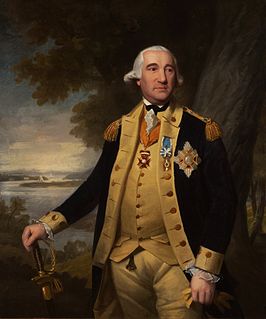 W
WEthnic Germans served on both sides of the American Revolutionary War. Many, notably rented auxiliary troops from Germanic states such as the Landgraviate of Hessen-Kassel, supported the Loyalist cause and served as allies of the Kingdom of Great Britain, whose King George III was also the Elector of Hanover.
 W
WThe Great Fire of New York was a devastating fire that burned through the night of September 20, 1776, and into the morning of September 21, on the West Side of what then constituted New York City at the southern end of the island of Manhattan. It broke out in the early days of the military occupation of the city by British forces during the American Revolutionary War.
 W
WHessians were German soldiers who served as auxiliaries to the British Army during the American Revolutionary War. The term is an American synecdoche for all Germans who fought on the British side, since 65% came from the German states of Hesse-Kassel and Hesse-Hanau. Known for their discipline and martial prowess, around 30,000 Germans fought for the British during war, comprising a quarter of British forces.
 W
WThe Hudson River Chain was two chain booms and two chevaux de frise constructed from 1776 to 1778 during the American Revolutionary War across the Hudson River as defenses to prevent British naval vessels from sailing upriver. These defenses along the Hudson River were overseen by the Highlands Department of the Continental Army. The most significant and successful was the Great Chain, constructed from West Point in 1778, and used through 1782 after the war's end. The huge links for the chains were forged at iron works in Orange County, New York.
 W
WIl Grande Blek is an Italian western comic book, first published in Italy on October 3, 1954 by Editoriale Dardo. Blek was written and illustrated by Giovanni Sinchetto, Dario Guzzon and Pietro Sartoris, also known as trio EsseGesse.
 W
WDuring the American Revolutionary War, the Continental Army and British Army conducted espionage operations against one another to collect military intelligence to inform military operations. In addition, both sides conducted political action, covert action, counterintelligence, deception, and propaganda operations as part of their overall strategies.
 W
WJewish Americans have served in the United States armed forces dating back to before the colonial era, when Jews had served in militias of the Thirteen Colonies. Jewish military personnel have served in all branches of the armed forces and in every major armed conflict to which the United States has been involved. According to the U.S. Department of Defense, as of 2006 there were currently 3,973 known Jewish servicemen and servicewomen on active duty.
 W
WJames Aitken, also known as John the Painter, was a mercenary who committed acts of sabotage in Royal Navy naval dockyards during the American Revolutionary War in 1776–77.
 W
WKnowlton's Rangers was an elite reconnaissance and espionage detachment of the Continental Army established by George Washington. Named after its commander, Thomas Knowlton, the unit was formed in 1776.
 W
WThe Lexington–Concord Sesquicentennial half dollar, sometimes the Lexington–Concord half dollar or Patriot half dollar, is a commemorative fifty-cent piece struck by the United States Bureau of the Mint in 1925 in honor of the 150th anniversary of the Battles of Lexington and Concord, which began the American Revolutionary War. It was designed by Chester Beach.
 W
WThe Middlebrook encampment was a seasonal encampment of the Continental Army, commanded by General George Washington, during the American War for Independence near Middle Brook in Bridgewater Township, New Jersey in 1777 and again in 1778–79. The site includes part of the ridge of the First Watchung Mountain. Its position provided a natural fortress not only protecting the Continental Army but also overlooking the plains towards New Brunswick, where the British forces were stationed in 1777. The strategic strength of the position contributed ultimately to the success of the Continental Army by lengthening the war and wearying the British forces.
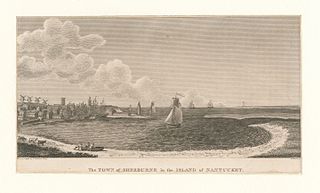 W
WThe citizens of Nantucket during the American Revolutionary War era relied on whaling, industries that supported whaling, and the trade in oil that resulted from that industry. Because most of this trade was with England, the leading citizens of Nantucket chose to be neutral during the American Revolutionary War, siding neither with those who supported revolution nor with the British Crown, in order to maintain the viability of the island's economy. The Quaker culture of pacifism was a secondary cause of the island's non-participation in revolutionary activities.
 W
WThe American Revolutionary War saw a series of military manoeuvres and battles involving naval forces of the British Royal Navy and the Continental Navy from 1775, and of the French Navy from 1778 onwards. While the British enjoyed more numerical victories these battles culminated in the surrender of the British Army force of Lieutenant-General Earl Charles Cornwallis, an event that led directly to the beginning of serious peace negotiations and the eventual end of the war. From the start of the hostilities, the British North American station under Vice-Admiral Samuel Graves blockaded the major colonial ports and carried raids against patriot communities. Colonial forces could do little to stop these developments due to British naval supremacy. In 1777, colonial privateers made raids into British waters capturing merchant ships, which they took into French and Spanish ports, although both were officially neutral. Seeking to challenge Britain, France signed two treaties with America in February 1778, but stopped short of declaring war on Britain. The risk of a French invasion forced the British to concentrate its forces in the English Channel, leaving its forces in North America vulnerable to attacks.
 W
WThe Newburgh Conspiracy was what appeared to be a planned military coup by the Continental Army in March 1783, when the American Revolutionary War was at its end. The conspiracy may have been instigated by members in the Congress of the Confederation, who circulated an anonymous letter in the army camp at Newburgh, New York, on March 10, 1783. Soldiers were unhappy that they had not been paid for some time and that pensions that had been promised remained unfunded. The letter suggested that they should take unspecified action against Congress to resolve the issue. The letter was said to have been written by Major John Armstrong, aide to General Horatio Gates, although the authorship of its text and underlying ideas is a subject of historical debate.
 W
WThe New World of the Western Hemisphere was devastated by the 1775–1782 North American smallpox epidemic. Columbus' first voyage to America can be attributed for bringing the smallpox virus to America and led to its spread across most of the continent of North America.
 W
WThe Pennamite–Yankee Wars or Yankee–Pennamite Wars were a series of conflicts consisting of the First Pennamite War (1769–1770), the Second Pennamite War (1774), and the Third Pennamite War (1784), in which the Wyoming Valley along the North Branch of the Susquehanna River was disputed between settlers from Connecticut (Yankees) and Pennsylvania (Pennamites).
 W
WThe Pennsylvania Line Mutiny was a mutiny of Continental Army soldiers, who demanded higher pay and better housing conditions, and was the cause of the legend and stories surrounding the American heroine Tempe Wick. The mutiny began on January 1, 1781, and ended with a negotiated settlement on January 8, 1781. The negotiated terms were finally concluded by January 29, 1781. The mutiny was the most successful and important insurrection of Continental Army soldiers during the American Revolutionary War.
 W
WThe Phrygian cap or liberty cap is a soft conical cap with the apex bent over, associated in antiquity with several peoples in Eastern Europe and Anatolia, including Phrygia, Dacia, and the Balkans. In first the American Revolution and then French Revolution it came to signify freedom and the pursuit of liberty, although Phrygian caps did not originally function as liberty caps. The original cap of liberty was the Roman pileus, the felt cap of manumitted (emancipated) slaves of ancient Rome, which was an attribute of Libertas, the Roman goddess of liberty. In the 16th century, the Roman iconography of liberty was revived in emblem books and numismatic handbooks where the figure of Libertas is usually depicted with a pileus. The most extensive use of a headgear as a symbol of freedom in the first two centuries after the revival of the Roman iconography was made in the Netherlands, where the cap of liberty was adopted in the form of a contemporary hat. In the 18th century, the traditional liberty cap was widely used in English prints and from 1789 also in French prints; by the early 1790s, it was regularly used in the Phrygian form.
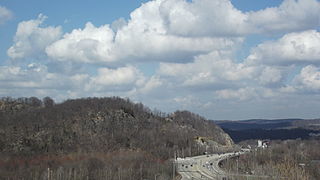 W
WThe Pompton Mutiny, also referred to as the Federal Hill Rebellion, was a revolt of Continental Army troops at Pompton Camp in what was then Pompton Township, New Jersey, present-day Bloomingdale, New Jersey, that occurred on January 20, 1781, beneath the command of Colonel Israel Shreve.
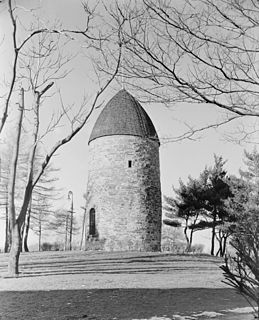 W
WThe Powder Alarm was a major popular reaction to the removal of gunpowder from a magazine by British soldiers under orders from General Thomas Gage, royal governor of the Province of Massachusetts Bay, on September 1, 1774. In response to this action, amid rumors that blood had been shed, alarm spread through the countryside to Connecticut and beyond, and American Patriots sprang into action, fearing that war was at hand. Thousands of militiamen began streaming toward Boston and Cambridge, and mob action forced Loyalists and some government officials to flee to the protection of the British Army.
 W
WDuring the American Revolutionary War (1775–1783), management and treatment of prisoners of war (POWs) was very different from the standards of modern warfare. Modern standards, as outlined in the Geneva Conventions of later centuries, assume that captives will be held and cared for by their captors. One primary difference in the 18th century was that care and supplies for captives were expected to be provided by their own combatants or private resources.
 W
WA Quaker gun is a deception tactic that was commonly used in warfare during the 18th and 19th centuries. Although resembling an actual cannon, the Quaker gun was simply a wooden log, usually painted black, used to deceive an enemy. Misleading the enemy as to the strength of an emplacement was an effective delaying tactic. The name derives from the Religious Society of Friends or "Quakers", who have traditionally held a religious opposition to war and violence in the Peace Testimony.
 W
WThe Recruiting Act 1778 is an Act of Parliament passed by the Parliament of Great Britain. It was a press Act "for the more easy and better recruiting of his Majesty's Land Forces". After the losses at the Battle of Saratoga in the American Revolutionary War and the apprehended hostilities with France, the existing voluntary enlistment measures were judged to be insufficient.
 W
WThe Recruiting Act 1779 was an Act of the Parliament of Great Britain. It was a press Act for the recruiting of his Majesty's Land Forces. After the losses in the American Revolutionary War and the apprehended hostilities with France, the existing voluntary enlistment measures were judged to be insufficient. It served as a revision of the Recruiting Act 1778.
 W
WThe Revolutionary War Door is an artwork by American sculptor Thomas Crawford, located on the United States Capitol House of Representatives wing east front in Washington, D.C., United States. This sculptured door was surveyed in 1993 as part of the Smithsonian's Save Outdoor Sculpture! program.
 W
WThe Salem Gunpowder Raid refers to a standoff between the British military and colonists in the town of Salem, Massachusetts, which was ended by a compromise agreement.
 W
WThe Saratoga Battle Monument is a 155-foot (47 m) granite obelisk located in the village of Victory, Saratoga County, New York. The monument commemorates what is called the "Turning Point" of the American Revolution—the surrender of British forces led by General John Burgoyne to the Americans under General Horatio Gates.
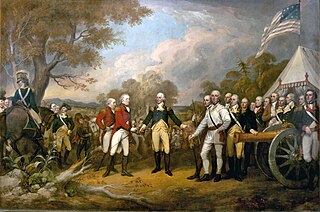 W
WThe Surrender of General Burgoyne is an oil painting by John Trumbull. The painting was completed in 1821, and hangs in the rotunda of the United States Capitol in Washington, D. C.
 W
WTekoa Mountain, 1,121 feet (342 m), is a dramatic, rocky high point overlooking the Westfield River Gorge at the eastern edge of the Berkshire plateau in the towns of Montgomery and Russell, Massachusetts, USA. Tekoa Mountain, very prominent from the "Jacob's Ladder" section of U.S. Route 20 in the town of Russell, is not a true mountain but a cleaver jutting from a dissected plateau; it was produced by glacial action and through continuous erosion by the Westfield River and Moose Meadow Brook before and after the last ice age.
 W
WThe Tomb of the Unknown Revolutionary War Soldier, also known as the Tomb of the Unknown Soldier of the American Revolution, is a war memorial located within Washington Square in Philadelphia, Pennsylvania. The memorial honors the thousands of soldiers who died during the American Revolutionary War, many of whom were buried in mass graves in the square. The tomb and Washington Square are part of Independence National Historical Park.
 W
WGeorge Washington commanded the Continental Army in the American Revolutionary War (1775–1783). After serving as President of the United States, he briefly was in charge of a new army in 1798.
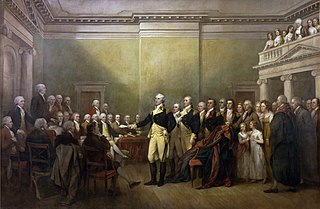 W
WGeorge Washington's resignation as commander-in-chief marked the end of Washington's military service in the American Revolutionary War and his return to civilian life at Mount Vernon. His voluntary action has been described as "one of the nation's great acts of statesmanship" and helped establish the precedent of civilian control of the military. After the Treaty of Paris ending the war had been signed on September 3, 1783, and after the last British troops left New York City on November 25, Washington resigned his commission as commander-in-chief of the Continental Army to the Congress of the Confederation, then meeting in the Maryland State House at Annapolis, Maryland, on December 23 of the same year. This followed his farewell to the Continental Army, November 2 at Rockingham near Princeton, New Jersey, and his farewell to his officers, December 4 at Fraunces Tavern in New York City. Washington's resignation was depicted by John Trumbull in 1824 with the life-size painting, General George Washington Resigning His Commission, now on view in the United States Capitol rotunda.
 W
WWolf Run Shoals was an important crossing point on the Occoquan River in northern Virginia between Alexandria and Richmond during the 18th and 19th centuries. It consisted of three islands and a mill, now submerged under the Occoquan due to higher water levels following damming for flood control, water supply, and power generation. It is located near the unincorporated communities of Butts Corner, Makleys Corner, and Farrs Corner in southern Fairfax County, Virginia.
 W
WWyoming Commemorative Association was founded in 1878 to commemorate the 100th anniversary of the Battle of Wyoming. This American Revolutionary War battle was fought on July 3, 1778, near Wilkes-Barre in present-day Exeter, Pennsylvania.